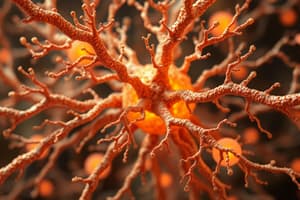Podcast
Questions and Answers
The ______ system is responsible for transmitting information throughout the body.
The ______ system is responsible for transmitting information throughout the body.
nervous
The CNS stands for central ______ system.
The CNS stands for central ______ system.
nervous
The brain is divided into several distinct regions including the cerebrum, midbrain, pons, medulla oblongata, and ______.
The brain is divided into several distinct regions including the cerebrum, midbrain, pons, medulla oblongata, and ______.
cerebellum
Neurons communicate with each other using ______, where neurotransmitters are released.
Neurons communicate with each other using ______, where neurotransmitters are released.
Information is received by the brain via nerves present in the ______ cavity.
Information is received by the brain via nerves present in the ______ cavity.
The CNS serves as the control center for the entire body through its regulation and integration of ______ from different sources.
The CNS serves as the control center for the entire body through its regulation and integration of ______ from different sources.
The PNS extends beyond the CNS and connects it to the rest of the body's organs and structures. It consists of twelve pairs of cranial nerves and several pairs of ______.
The PNS extends beyond the CNS and connects it to the rest of the body's organs and structures. It consists of twelve pairs of cranial nerves and several pairs of ______.
The primary function of the PNS is to transmit information between the body and the CNS. It communicates sensory input such as touch, taste, sight, hearing, and other stimuli from ______ present throughout the body.
The primary function of the PNS is to transmit information between the body and the CNS. It communicates sensory input such as touch, taste, sight, hearing, and other stimuli from ______ present throughout the body.
Neurotransmitters are specialized chemical substances released by neurons to transmit signals across ______.
Neurotransmitters are specialized chemical substances released by neurons to transmit signals across ______.
Some of the most common neurotransmitters include dopamine, serotonin, glutamate, acetylcholine, histamine, and ______.
Some of the most common neurotransmitters include dopamine, serotonin, glutamate, acetylcholine, histamine, and ______.
Nervous tissue plays a critical role in maintaining the intricate balance of bodily functions through the integration and transmission of information within the central and peripheral nervous systems. Any damage or dysfunction within these complex networks can have severe consequences for overall health and ______.
Nervous tissue plays a critical role in maintaining the intricate balance of bodily functions through the integration and transmission of information within the central and peripheral nervous systems. Any damage or dysfunction within these complex networks can have severe consequences for overall health and ______.
The PNS receives signals from the CNS through its motor neurons, initiating actions, reflexes, and controlling muscle ______.
The PNS receives signals from the CNS through its motor neurons, initiating actions, reflexes, and controlling muscle ______.
Study Notes
Nervous Tissue: Anatomy of the Central and Peripheral Nervous System
The nervous system is responsible for transmitting information throughout the body. It consists of two primary divisions: the central nervous system (CNS) and the peripheral nervous system (PNS). Both divisions contain specialized cells known as nerve cells. These intricate structures facilitate communication between various parts of the organism and play essential roles in cognition, motor functions, and sensory experiences.
Central Nervous System: Intricacies of the Brain and Spinal Cord
Anatomical Structure
The CNS includes the brain and spinal cord. The brain is divided into several distinct regions including the cerebrum, midbrain, pons, medulla oblongata, and cerebellum. Each region performs specific tasks related to thought processes, sensory perception, and motor coordination.
Functions
The CNS serves as the control center for the entire body through its regulation and integration of signals from different sources. Information is received by the brain via nerves present in the cranial cavity. This transmission occurs due to electrochemical impulses generated within specialized cellular structures called neurons. Neurons communicate with each other using synapses, where neurotransmitters are released by pre-synaptic terminals and bind to receptors on post-synaptic terminals to initiate responses.
Peripheral Nervous System: Complex Web of Sensory and Motor Pathways
Anatomical Structure
The PNS extends beyond the CNS and connects it to the rest of the body's organs and structures. It consists of twelve pairs of cranial nerves and several pairs of spinal nerves. These nerves are responsible for transmitting sensory information from various parts of the body to the brain and motor commands from the brain to muscles.
Functions
The primary function of the PNS is to transmit information between the body and the CNS. It communicates sensory input such as touch, taste, sight, hearing, and other stimuli from receptors present throughout the body. In turn, it receives signals from the CNS through its motor neurons, initiating actions, reflexes, and controlling muscle movement.
Neurotransmitters: Chemical Messengers Facilitating Communication within the Nervous System
Neurotransmitters are specialized chemical substances released by neurons to transmit signals across synapses. They play crucial roles in communication within the nervous system by acting as chemical messengers, facilitating interaction between cells and regulating various physiological processes. Some of the most common neurotransmitters include dopamine, serotonin, glutamate, acetylcholine, histamine, and gamma-aminobutyric acid (GABA).
In summary, nervous tissue plays a critical role in maintaining the intricate balance of bodily functions through the integration and transmission of information within the central and peripheral nervous systems. As a result, any damage or dysfunction within these complex networks can have severe consequences for overall health and well-being.
Studying That Suits You
Use AI to generate personalized quizzes and flashcards to suit your learning preferences.
Description
Test your knowledge on the anatomy of the nervous system, including the central nervous system (CNS) and peripheral nervous system (PNS). Explore the intricacies of the brain, spinal cord, neurons, neurotransmitters, and their roles in transmitting information throughout the body.




